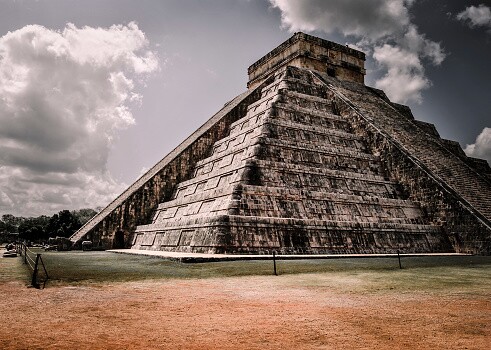First and Second Nephi, the first two books of the Book of Mormon, record the history of one of Latter-day Saints' most well-known families: the Nephites and the Lamanites.
And while Latter-day Saints know the names of Lehi, Sariah, Nephi, Laman, Lemuel, Sam, Zoram, and Ishmael, they may not know some of the details behind their involvement in early Nephite and Lamanite history.
Here are five important details you probably didn't know about Lehi and his family from First and Second Nephi.
1. Ishmael could have been related to Lehi.
It may seem a little strange that of all the families living in Jerusalem at the time of Lehi's departure, Lehi selected Ishmael's family to marry into his.
But this could have been because Ishmael was related to Lehi. That would explain, in a city full of wicked people, how Lehi knew a family that would be able to feel the promptings of the Spirit to leave Jerusalem behind and settle in the promised land.
There is also the fact that Nephi doesn't spend much time describing Lehi's reasoning for selecting Ishmael and his family. As Latter-day Saint scholar Hugh Nibley writes:
"The interesting thing is that Nephi takes Ishmael (unlike Zoram) completely for granted, never explaining who he is or how he fits into the picture—the act of sending for him seems to be the most natural thing in the world, as does the marriage of his daughters with Lehi’s sons. Since it has ever been the custom among the desert people for a man to marry the daughter of his paternal uncle (bint ’ammi), it is hard to avoid the impression that Lehi and Ishmael were related" (Hugh Nibely, "Lehi in the Deseret," 40).
2. How Ishmael's wife and daughters saved Nephi's life.
On several occasions, Laman and Lemuel tried to take Nephi's life. On one occasion, Laman and Lemuel had even bound Nephi and were determined to leave him in the desert to be "devoured by wild beasts" (1 Nephi 7:16).
According to Hugh Nibley, this was actually a common practice in the desert if you wanted to get rid of someone you didn't like.
"You won’t kill a person; that’s murder. But if you tie him up and just leave him there, you don’t have to worry. Let the animals carry it out. That’s a custom you read about in the Arab poets, etc" (Hugh Nibley, Teachings of the Book of Mormon, 1:169).
But when Nephi escaped his bounds, Laman and Lemuel decided to try to take Nephi's life in earnest. That's when something really interesting happens. Ishmael's wife and daughter plead with Laman and Lemuel to spare Nephi's life, and they do.
"All that saved Nephi’s life on one occasion was the pleading of a daughter of Ishmael and her mother—another authentic touch, since the proud Semite may yield only to the entreaties of a woman without losing face" (Hugh Nibley, Teachings of the Book of Mormon, 1:169).
It was an ancient act of chivalry for men to yield to the pleas of women, one that is repeated later in the Book of Mormon when the daughters of Nephites are sent to plead with Lamanites when the land of Nephi was under attack in Mosiah 19.
"And it came to pass that those who tarried with their wives and their children caused that their fair daughters should stand forth and plead with the Lamanites that they would not slay them. "And it came to pass that the Lamanites had compassion on them, for they were charmed with the beauty of their women" (Mosiah 19: 13–14)."
And in 1 Nephi 18:19, Nephi's wife and children plead with Laman and Lemuel to untie Nephi. The severity of the situation is clear when Laman and Lemuel refuse Nephi's wife's and children's pleas.
"And there was nothing save it were the power of God, which threatened them with destruction, could soften their hearts; wherefore, when they saw that they were about to be swallowed up in the depths of the sea they repented of the thing which they had done, insomuch that they loosed me" (1 Nephi 18:20).
3. Nephi's bow was a symbol of political power.
Though the story of Nephi's bow breaking is fairly well known, there is another side of this story that may not be.
While in the wilderness, Nephi's steel bow broke. With Laman's and Lemuel's having already lost their springs, Nephi's bow was heavily relied upon for hunts that brought their families food. But fixing the problem and creating a bow out of wood also had symbolic meaning.
"Bows were symbols of political power. One thinks of Odysseus bending the bow to prove himself. An overlord would break the bow of a disobedient vassal to symbolically put the rebel in his place" (see also Jeremiah 49:35; 51:56). That detail is significant in 1 Nephi 16. Nephi's bow broke, and the bows of Laman and Lemuel lost their springs, but when Nephi fashioned a new bow, making him the only one in camp with a bow, his brothers soon accused Nephi of having political ambitions" (William Hamblin, "Nephi's Bows and Arrows").
This could explain Laman and Lemuel's reasoning behind their murmurings that Nephi wanted to rule over them and their families. Incidentally, Nephi did become a leader, not over his older brothers but to the people who followed him to become the early Nephites.
4. Lehi and Sariah most likely had daughters in the wilderness.
There is only one direct mention of Nephi's sisters in the Book of Mormon.
"Wherefore, it came to pass that I, Nephi, did take my family, and also Zoram and his family, and Sam, mine elder brother and his family, and Jacob and Joseph, my younger brethren, and also my sisters, and all those who would go with me. And all those who would go with me were those who believed in the warnings and the revelations of God; wherefore, they did hearken unto my words" (2 Nephi 5:6).
The fact that these faithful women were not mentioned by name could be because of Hebrew customs of the time, which would explain why Nephi's wife was also not named in the Book of Mormon (McConkie and Millet, Doctrinal Commentary, 1:123–24).
Because of this, it's likely that Lehi and Sariah had daughters during their travels through the wilderness and promised land.
"That Nephi mentions 'sisters' in the plural means that at least two went with him. He does not refer to these sisters as the wives of Ishmael's sons. And those married sisters, who had rebelled from the time they first came out of Jerusalem, would probably not have left their husbands to go with Nephi without his mentioning the fact. More likely, the sisters who accompanied Nephi were younger, born in the wilderness. That the birth of girls is not mentioned agrees with the custom of that day. Joseph is called Lehi's 'last-born . . . in the wilderness,' but 'first-born' and 'last-born' usually referred only to sons. More to the point, Nephi describes all who went with him as believers in the warnings and revelations of God. That speaks highly of his younger sisters" (Jerrie W. Hurd, "Our Sisters in the Latter-day Scriptures," 10).
5. Zoram could have been adopted into the House of Israel.
Though Nephi promised Zoram that he would be a "free man like unto us" (1 Nephi 4:33) if Zoram followed Nephi and his family into the wilderness, it appears Zoram was adopted into Lehi's family.
Before his death, Lehi gave Zoram a patriarchal blessing, something that Lehi did for all his children and their prosperity.
"And now, Zoram, I speak unto you: Behold, thou art the servant of Laban; nevertheless, thou hast been brought out of the land of Jerusalem, and I know that thou art a true friend unto my son, Nephi, forever. "Wherefore, because thou hast been faithful thy seed shall be blessed with his seed, that they dwell in prosperity long upon the face of this land; and nothing, save it shall be iniquity among them, shall harm or disturb their prosperity upon the face of this land forever. "Wherefore, if ye shall keep the commandments of the Lord, the Lord hath consecrated this land for the security of thy seed with the seed of my son (2 Nephi 1:30–32).
Because Zoram was a servant of Laban, it's also very possible that he was not an Israelite by birth. By extending this patriarchal blessing, Lehi could have been acknowledging that Zoram was adopted into the House of Israel.
"We do not know the ethnic background or bloodline of Zoram, the true friend of Nephi. Being a servant to Laban suggests he was not of the blood of Israel. Regardless, as patriarch of Joseph's branch of Israel, Lehi extends all the blessings of the Lord to this faithful man and to his seed. If he were not of the house of Israel, he was adopted into it. These blessings were to come through the family unit of Nephi (another suggestion that he was not of the blood of Israel), but were conditional upon their keeping the commandments of the Lord" (Monte Lyman, "Book of Mormon Commentary: I, Nephi, Wrote This Record," 1: 379).
Lead image from Getty Images
As we study this keystone of our religion, what help can we find to help us see and understand its doctrines more deeply?
The Book of Mormon Study Guide: Start to Finish is a comprehensive, question-and-answer commentary that draws from thousands of the very best insights on the scriptures, including those from General Authorities, Church magazines and manuals, the most respected scholarly commentaries, scripture reference books, and other publications. This comprehensive volume brings the most unique, most compelling, and most insightful comments on the Book of Mormon together into one place to help you get more out of your personal scripture study. As we ask inspired questions and seek a deeper understanding of the scriptures, we invite personal revelation to help us in our challenging and ever-changing journey of life.




